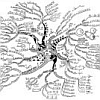| |
  
Gabriel Cardona,
Francesc Rosselló and
Gabriel Valiente. Tripartitions do not always discriminate phylogenetic networks. In MBIO, Vol. 211(2):356-370, 2008.
Keywords: distance between networks, phylogenetic network, phylogeny, Program Bio PhyloNetwork, tree-child network, tripartition distance.
Note: http://arxiv.org/abs/0707.2376, slides available at http://www.newton.cam.ac.uk/webseminars/pg+ws/2007/plg/plgw01/0904/valiente/.
Toggle abstract
"Phylogenetic networks are a generalization of phylogenetic trees that allow for the representation of non-treelike evolutionary events, like recombination, hybridization, or lateral gene transfer. In a recent series of papers devoted to the study of reconstructibility of phylogenetic networks, Moret, Nakhleh, Warnow and collaborators introduced the so-called tripartition metric for phylogenetic networks. In this paper we show that, in fact, this tripartition metric does not satisfy the separation axiom of distances (zero distance means isomorphism, or, in a more relaxed version, zero distance means indistinguishability in some specific sense) in any of the subclasses of phylogenetic networks where it is claimed to do so. We also present a subclass of phylogenetic networks whose members can be singled out by means of their sets of tripartitions (or even clusters), and hence where the latter can be used to define a meaningful metric. © 2007 Elsevier Inc. All rights reserved."
|
|
| |
  
Gabriel Cardona,
Francesc Rosselló and
Gabriel Valiente. A Perl Package and an Alignment Tool for Phylogenetic Networks. In BMCB, Vol. 9:175, 2008.
Keywords: distance between networks, phylogenetic network, phylogeny, Program Bio PhyloNetwork, tree sibling network, tree-child network.
Note: http://dx.doi.org/10.1186/1471-2105-9-175.
Toggle abstract
"Background: Phylogenetic networks are a generalization of phylogenetic trees that allow for the representation of evolutionary events acting at the population level, like recombination between genes, hybridization between lineages, and lateral gene transfer. While most phylogenetics tools implement a wide range of algorithms on phylogenetic trees, there exist only a few applications to work with phylogenetic networks, none of which are open-source libraries, and they do not allow for the comparative analysis of phylogenetic networks by computing distances between them or aligning them. Results: In order to improve this situation, we have developed a Perl package that relies on the BioPerl bundle and implements many algorithms on phylogenetic networks. We have also developed a Java applet that makes use of the aforementioned Perl package and allows the user to make simple experiments with phylogenetic networks without having to develop a program or Perl script by him or herself. Conclusion: The Perl package is available as part of the BioPerl bundle, and can also be downloaded. A web-based application is also available (see availability and requirements). The Perl package includes full documentation of all its features. © 2008 Cardona et al; licensee BioMed Central Ltd."
|
|
| |
  
Steven M. Woolley,
David Posada and
Keith A. Crandall. A Comparison of Phylogenetic Network Methods Using Computer Simulation. In PLoS ONE, Vol. 3(4):e1913, 2008.
Keywords: abstract network, distance between networks, evaluation, median network, MedianJoining, minimum spanning network, NeighborNet, parsimony, phylogenetic network, phylogeny, Program Arlequin, Program CombineTrees, Program Network, Program SHRUB, Program SplitsTree, Program TCS, split decomposition.
Note: http://dx.doi.org/10.1371/journal.pone.0001913.
Toggle abstract
"Background: We present a series of simulation studies that explore the relative performance of several phylogenetic network approaches (statistical parsimony, split decomposition, union of maximum parsimony trees, neighbor-net, simulated history recombination upper bound, median-joining, reduced median joining and minimum spanning network) compared to standard tree approaches (neighbor-joining and maximum parsimony) in the presence and absence of recombination. Principal Findings: In the absence of recombination, all methods recovered the correct topology and branch lengths nearly all of the time when the subtitution rate was low, except for minimum spanning networks, which did considerably worse. At a higher substitution rate, maximum parsimony and union of maximum parsimony trees were the most accurate. With recombination, the ability to infer the correct topology was halved for all methods and no method could accurately estimate branch lengths. Conclusions: Our results highlight the need for more accurate phylogenetic network methods and the importance of detecting and accounting for recombination in phylogenetic studies. Furthermore, we provide useful information for choosing a network algorithm and a framework in which to evaluate improvements to existing methods and novel algorithms developed in the future. © 2008 Woolley et al."
|
|
| |
   
Gabriel Cardona,
Mercè Llabrés,
Francesc Rosselló and
Gabriel Valiente. A Distance Metric for a Class of Tree-Sibling Phylogenetic Networks. In BIO, Vol. 24(13):1481-1488, 2008.
Keywords: distance between networks, phylogenetic network, phylogeny, polynomial, tree sibling network.
Note: http://dx.doi.org/10.1093/bioinformatics/btn231.
Toggle abstract
"Motivation: The presence of reticulate evolutionary events in phylogenies turn phylogenetic trees into phylogenetic networks. These events imply in particular that there may exist multiple evolutionary paths from a non-extant species to an extant one, and this multiplicity makes the comparison of phylogenetic networks much more difficult than the comparison of phylogenetic trees. In fact, all attempts to define a sound distance measure on the class of all phylogenetic networks have failed so far. Thus, the only practical solutions have been either the use of rough estimates of similarity (based on comparison of the trees embedded in the networks), or narrowing the class of phylogenetic networks to a certain class where such a distance is known and can be efficiently computed. The first approach has the problem that one may identify two networks as equivalent, when they are not; the second one has the drawback that there may not exist algorithms to reconstruct such networks from biological sequences. Results: We present in this articlea distance measure on the class of semi-binary tree-sibling time consistent phylogenetic networks, which generalize tree-child time consistent phylogenetic networks, and thus also galled-trees. The practical interest of this distance measure is 2-fold: it can be computed in polynomial time by means of simple algorithms, and there also exist polynomial-time algorithms for reconstructing networks of this class from DNA sequence data. © 2008 The Author(s)."
|
|
| |
   
Gabriel Cardona,
Mercè Llabrés,
Francesc Rosselló and
Gabriel Valiente. Phylogenetic Networks: Justification, Models, Distances and Algorithms. In VI Jornadas de Matemática Discreta y Algorítmica (JMDA'08), 2008.
Keywords: distance between networks, mu distance, phylogenetic network, phylogeny, polynomial, survey, time consistent network, tree-child network, tripartition distance, triplet distance.
Note: http://bioinfo.uib.es/media/uploaded/jmda2008_submission_61-1.pdf.
|
|
|
 - forked on GitHub.
- forked on GitHub.





















































